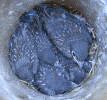First the very important issue of habitat. Birds can nest in bushes, vines, trees – both living and dead.- in planters, garages, overhangs whatever seems good. Usually they choose pretty good sites for their nests….because in their “birdy” wisdom they feel it is safe and secure and handy.
However they often do not take into account human activity or the activity of our pets…cats in particular. Wherever possible we should all try to think about animal habitat before doing ANYTHING to our natural surroundings. Try not to do any tree cutting or brush cutting in the spring or early summer or at least check very carefully for any inhabitants before doing so.
Hatchlings:
Newly out of the egg, naked and totally defenseless. Parents must “brood” these little ones to keep them warm until they grow enough hair and feathers to take care of this themselves. They may have a small amount of down or fuzz on them.
Nestlings:
As they grow in the nest they are called nestlings. They pretty much sleep, peep, eat and poop. They are starting to grow their feathers.
 The small song birds grow rapidly in the nest and basically start to outgrow it.Sadly sometimes some of the little ones will be pushed out of the nest by their siblings. If you come across such a situation and you can locate the nest,just put the baby back. Do not worry about the “smell of human” on the baby. Birds generally have a terrible sense of smell.
The small song birds grow rapidly in the nest and basically start to outgrow it.Sadly sometimes some of the little ones will be pushed out of the nest by their siblings. If you come across such a situation and you can locate the nest,just put the baby back. Do not worry about the “smell of human” on the baby. Birds generally have a terrible sense of smell.
Considering the state of most nests (especially those of birds like raptors) by the time the youngsters have grown, it is a good thing they don’t have a sense of smell! If you find a fallen nest just put it and it’s occupants back in a sturdy and safe spot up high.
Fledglings:
Fledglings are bigger than nestlings, and they have a lot more hair and feathers on their bodies.A fledgling is generally out of its nest for one reason – it is attempting to fly. Often, a mother bird will place a fledgling in a remote area, and leave it alone for a certain amount of time. Fledglings know how to cry out for help if they need it, and an older bird is never far  away. Try not to pick up a fledgling and certainly do not feed it. However,you might break that rule if the fledging was in imminent danger.
away. Try not to pick up a fledgling and certainly do not feed it. However,you might break that rule if the fledging was in imminent danger.
If you see that there are nests in the area of your house, it is best to keep any cats inside until the young have safely fledged.
For songbirds the total time from hatching to fledging ranges from 9 to 21 days. Large raptors like Bald Eagles are in the nest for 12-14 weeks by comparison.
So, if you see a fallen bird, try to determine whether it is a fledgling or a nestling – and if it is a fledgling – whether i it is in imminent danger. Once you have figured out what sort of bird you are dealing with, only then can you help it, or leave it alone. If in doubt you can call GROWLS at 250-714-7101.
If your fledgling is an eagle or a heron and seems in trouble or danger then definitely call GROWLS. These are very dangerous birds to handle and a part from keeping them safe from traffic or dogs etc…you should stay back and wait until the GROWLS volunteers arrive.